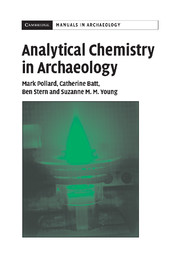Book contents
- Frontmatter
- Contents
- List of figures
- List of tables
- Preface
- PART I THE ROLE OF ANALYTICAL CHEMISTRY IN ARCHAEOLOGY
- PART II THE APPLICATION OF ANALYTICAL CHEMISTRY TO ARCHAEOLOGY
- 3 ELEMENTAL ANALYSIS BY ABSORPTION AND EMISSION SPECTROSCOPIES IN THE VISIBLE AND ULTRAVIOLET
- 4 MOLECULAR ANALYSIS BY ABSORPTION AND RAMAN SPECTROSCOPY
- 5 X-RAY TECHNIQUES AND ELECTRON BEAM MICROANALYSIS
- 6 NEUTRON ACTIVATION ANALYSIS
- 7 CHROMATOGRAPHY
- 8 MASS SPECTROMETRY
- 9 INDUCTIVELY COUPLED PLASMA–MASS SPECTROMETRY (ICP–MS)
- PART III SOME BASIC CHEMISTRY FOR ARCHAEOLOGISTS
- Epilogue
- Appendices
- References
- Index
7 - CHROMATOGRAPHY
Published online by Cambridge University Press: 03 May 2010
- Frontmatter
- Contents
- List of figures
- List of tables
- Preface
- PART I THE ROLE OF ANALYTICAL CHEMISTRY IN ARCHAEOLOGY
- PART II THE APPLICATION OF ANALYTICAL CHEMISTRY TO ARCHAEOLOGY
- 3 ELEMENTAL ANALYSIS BY ABSORPTION AND EMISSION SPECTROSCOPIES IN THE VISIBLE AND ULTRAVIOLET
- 4 MOLECULAR ANALYSIS BY ABSORPTION AND RAMAN SPECTROSCOPY
- 5 X-RAY TECHNIQUES AND ELECTRON BEAM MICROANALYSIS
- 6 NEUTRON ACTIVATION ANALYSIS
- 7 CHROMATOGRAPHY
- 8 MASS SPECTROMETRY
- 9 INDUCTIVELY COUPLED PLASMA–MASS SPECTROMETRY (ICP–MS)
- PART III SOME BASIC CHEMISTRY FOR ARCHAEOLOGISTS
- Epilogue
- Appendices
- References
- Index
Summary
The extraction of samples for organic residue analysis is discussed in Section 13.2. However, in almost all cases, this is not sufficient to enable identification of the sample. Archaeological residues are often a complex mixture of original molecules, degradation products, contamination from the burial matrix and finds processing, storage, etc. Further separation of the mixture, combined with identification of the components, is required. Chromatography is used to separate mixtures into their molecular components. Although chromatography may be used for the separation of inorganic compounds and their different species, this chapter focuses on chromatographic techniques associated with organic molecules. We start with the “classical” techniques of column chromatography and thin layer chromatography (TLC) – now not primarily used as analytical tools in their own right, but often as preparative methods for more detailed analysis. We then discuss the principles of gas chromatography (GC) and high performance liquid chromatography (HPLC). Because of the long history of these techniques, they are well described in general analytical textbooks (e.g., Ewing 1985, Skoog et al. 1998), as well as more specialist volumes on chromatographic analysis (e.g., Ahuja 2003, Poole 2003). The technique of GC is described in detail by Baugh (1993). We defer a discussion of mass spectrometric techniques coupled to chromatography until Chapter 8.
Principles of chromatography
Chromatography separates molecules by their physical behavior, and not by their chemical reactions. Therefore, the determining factors in chromatographic separation are molecular weight, functional group types, and molecular shape.
- Type
- Chapter
- Information
- Analytical Chemistry in Archaeology , pp. 137 - 159Publisher: Cambridge University PressPrint publication year: 2007

